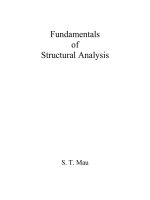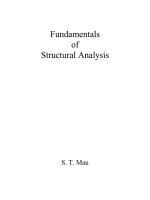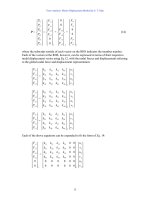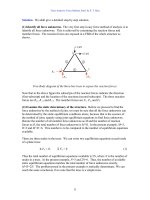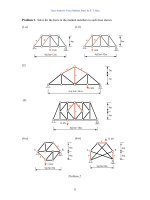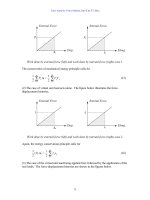Fundamentals of Structural Analysis P2 doc
Bạn đang xem bản rút gọn của tài liệu. Xem và tải ngay bản đầy đủ của tài liệu tại đây (236.07 KB, 20 trang )
Truss Analysis: Matrix Displacement Method by S. T. Mau
25
⎥
⎥
⎥
⎦
⎤
⎢
⎢
⎢
⎣
⎡
−−−
−
80.3760.900.25080.1260.900
000000.25000.250
033.330000033.33
⎪
⎪
⎪
⎪
⎭
⎪
⎪
⎪
⎪
⎬
⎫
⎪
⎪
⎪
⎪
⎩
⎪
⎪
⎪
⎪
⎨
⎧
0
0
0
4
3
3
2
2
u
v
u
v
u
=
⎪
⎭
⎪
⎬
⎫
⎪
⎩
⎪
⎨
⎧
4
1
1
y
y
x
P
P
P
For the second truss:
⎥
⎥
⎥
⎦
⎤
⎢
⎢
⎢
⎣
⎡
−−−
−−−
−−−
80.3760.900.25080.1260.900
0080.1260.900.25080.3760.9
033.3360.920.70060.953.40
⎪
⎪
⎪
⎪
⎭
⎪
⎪
⎪
⎪
⎬
⎫
⎪
⎪
⎪
⎪
⎩
⎪
⎪
⎪
⎪
⎨
⎧
0
0
0
4
3
3
2
2
u
v
u
v
u
=
⎪
⎭
⎪
⎬
⎫
⎪
⎩
⎪
⎨
⎧
4
1
1
y
y
x
P
P
P
Results will be summarized at the end of the example.
(7) Compute the member elongations and forces.
For a typical member i:
∆
i
=
⎣⎦
i
SCSC −−
i
v
u
v
u
⎪
⎪
⎭
⎪
⎪
⎬
⎫
⎪
⎪
⎩
⎪
⎪
⎨
⎧
2
2
1
1
F
i
=(k
∆
)
ι
= (
L
EA
∆
)
ι
(8) Summarizing results.
Truss Analysis: Matrix Displacement Method by S. T. Mau
26
Results for the First Truss
Displacement (m) Force (MN)
Node
x-direction y-direction x-direction y-direction
1 0 0 -0.50 0.33
2 0.066 -0.013 0.60 -1.00
3 0.067 0 0 0
4 0.015 0 0 0.67
Member Elongation (m) Force (MN)
1 -0.013 -0.33
20 0
30 0
4 0.015 0.50
5 -0.042 -0.83
Results for the Second Truss
Displacement (m) Force (MN)
Node
x-direction y-direction x-direction y-direction
1 0 0 -0.50 0.33
2 0.033 -0.021 0.60 -1.00
3 0.029 -0.007 0 0
4 0.011 0 0 0.67
Member Elongation (m) Force (MN)
1 -0.021 -0.52
2 -0.004 -0.14
3 -0.008 -0.19
4 0.011 0.36
5 0.030 -0.60
6 0.012 0.23
Note that the reactions at node 1 and 4 are identical in the two cases, but other results are
changed by the addition of one more diagonal member.
(9) Concluding remarks.
If the number of nodes is N and the number of constrained DOF is C, then
(a) the number of simultaneous equations in the unconstrained stiffness equation is
2N.
(b) the number of simultaneous equations for the solution of unknown nodal
displacements is 2N-C.
Truss Analysis: Matrix Displacement Method by S. T. Mau
27
In the present example, both truss problems have five equations for the five unknown
nodal displacements. These equations cannot be easily solved with hand calculation
and should be solved by computer.
Problem 3. The truss shown is made of members with properties E=70 GPa and
A=1,430 mm
2
. Use a computer to find support reactions, member forces, member
elongations, and all nodal displacements for (a) a unit load applied vertically at the
mid-span node of the lower chord members, and (b) a unit load applied vertically at
the first internal lower chord node. Draw the deflected configuration in each case.
Problem 3.
7. Kinematic Stability
In the above analysis, we learned that the unconstrained stiffness matrix is always
singular, because the truss is not yet supported, or constrained. What if the truss is
supported but not sufficiently or properly supported or the truss members are not properly
placed? Consider the following three examples. Each is a variation of the example truss
problem we have just solved.
Three unstable truss configurations
1
4 m
4@3 m = 12 m
Truss Analysis: Matrix Displacement Method by S. T. Mau
28
(1) Truss at left. The three roller supports provide constraints only in the vertical
direction but not in the horizontal direction. As a result, the truss can move in the
horizontal direction indefinitely. There is no resistance to translation in the horizontal
direction.
(2) Truss in the middle. The reactions provided by the supports all point to node 1. As a
result, the reaction forces cannot counter-balance any applied force which produces a
non-zero moment about node 1. The truss is not constrained against rotation about node
1.
(3) Truss at the right. The supports are fine, providing constraints against translation as
well as rotation. The members of the truss are not properly placed. Without a diagonal
member, the truss will change shape as shown. The truss can not maintain its shape
against arbitrarily applied external forces at the nodes.
The first two cases are such that the truss are externally unstable. The last one is
internally unstable. The resistance against changing shape or location as a mechanism is
called kinematic stability. While kinematic stability or instability can be inspected
through visual observation, mathematically it manifests itself in the characteristics of the
constrained global stiffness matrix. If the matrix is singular, then we know the truss is
kinematically unstable. In the example problems in the last section, the two 5x5 stiffness
matrices are both non-singular, otherwise we would not have been able to obtain the
displacement solutions. Thus, kinematic stability of a truss can be tested mathematically
by investigating the singularity of the constrained global stiffness matrix of a truss. In
practice, if the displacement solution appears to be arbitrarily large or disproportionate
among some displacements, then it maybe the sign of an unstable truss configuration.
Sometimes, kinematic instability can be detected by counting constraints or unknown
forces:
External Instability. External Instability happens if there is insufficient number of
constraints. Since it takes at least three constraints to prevent translation and rotation of
an object in a plane, any support condition that provides only one or two constraints will
result in instability. The left truss in the figure below has only two support constraints and
is unstable.
Internal Instability. Internal instability happens if the total number of force unknowns is
less than the number of displacement DOFs. If we denote the number of member force
unknowns as M and support reaction unknowns as R. Then internal instability results if
M+R < 2N. The truss at the right in the figure below has M=4 and R=3 but 2N=8. It is
unstable.
Truss Analysis: Matrix Displacement Method by S. T. Mau
29
Kinematic instability resulting from insufficient number of supports or members.
Problem 4: Discuss the kinematic stability of each of the plane truss shown.
(1) (2)
(3) (4)
(5) (6)
(7) (8)
(9) (10)
Problem 4.
Truss Analysis: Matrix Displacement Method by S. T. Mau
30
8. Summary
The fundamental concept in the displacement method and the procedures of solution are
the following:
(1) If all the key displacement quantities of a given problem are known, then the
deformation of each member can be computed using the conditions of compatibility,
which is manifested in the form of Eq. 2 through Eq. 4.
(2) Knowing the member deformation, we can then compute the member force using the
member stiffness equation, Eq. 1.
(3) The member force of a member can be related to the nodal forces expressed in the
global coordinate system by Eq. 7 or Eq. 8, which is the forced transformation
equation.
(4) The member nodal forces and the externally applied forces are in equilibrium at each
node, as expressed in Eq. 14, which is the global equilibrium equation in terms of
nodal forces.
(5) The global equilibrium equation can then be expressed in terms of nodal
displacements through the use of member stiffness equation, Eq. 11. The result is the
global stiffness equation in terms of nodal displacements, Eq. 15.
(6) Since not all the nodal displacements are known, we can solve for the unknown
displacements from the constrained global stiffness equation, Eq. 16 in Example 3.
(7) Once all the nodal forces are computed, the remaining unknown quantities are
computed by simple substitution.
The displacement method is particularly suited for computer solution because the
solution steps can be easily programmed through the direct stiffness method of
assembling the stiffness equation. The correct solution can always be computed if the
structure is stable ( kinematically stable), which means the structure is internally properly
connected and externally properly supported to prevent it from becoming a mechanism
under any loading conditions.
31
Truss Analysis: Force Method, Part I
1. Introduction
In the chapter on matrix displacement method of truss analysis, truss analysis is
formulated with nodal displacement unknowns as the fundamental variables to be
determined. The resulting method of analysis is simple and straightforward and is very
easy to be implemented into a computer program. As a matter of fact, virtually all
structural analysis computer packages are coded with the matrix displacement method.
The one drawback of the matrix displacement method is that it does not provide any
insight on how the externally applied loads are transmitted and taken up by the members
of the truss. Such an insight is critical when an engineer is required not only to analyze a
given truss but also to design a truss from scratch.
We will now introduce a different approach, the force method. The essence of the force
method is the formulation of the governing equations with the forces as unknown
variables. The beginning point of the force method is the equilibrium equations
expressed in terms of forces. Depending on how the free-body-diagrams are selected to
develop these equilibrium equations, we may use either the method of joint or the method
of section or a combination of both to solve a truss problem.
In the force method of analysis, if the force unknowns can be solved by the equilibrium
equations alone, then the solution process is very straightforward: finding member forces
from equilibrium equations, finding member elongation from member forces, and finding
nodal displacements from member elongation. Assuming that the trusses considered
herein are all kinematically stable, the only other pre-requisite for such a solution
procedure is that the truss be a statically determinate one, i.e., the total number of force
unknowns is equal to the number of independent equilibrium equations. In contrast, a
statically indeterminate truss, which has more force unknowns than the number of
independent equilibrium equations, requires the introduction of additional equations
based on the geometric compatibility or consistent deformations to supplement the
equilibrium equations. We shall study the statically determinate problems first,
beginning by a brief discussion of determinacy and truss types.
2. Statically Determinate Plane Truss Types
For statically determinate trusses, the force unknowns, consisting of M member forces if
there are M members, and R reactions, are equal in number to the equilibrium equations.
Since one can generate two equilibrium equations from each node, the number of
independent equilibrium equations is 2N, where N is the number of nodes. Thus by
definition M+R=2N is the condition of statical determinacy. This is to assume that the
truss is stable, because it is meaningless to ask whether the truss is determinate if it is not
stable. For this reason, stability of a truss should be examined first. One class of plane
Truss Analysis: Force Method, Part I by S. T. Mau
32
trusses, called simple truss, is always stable and determinate if properly supported
externally. A simple truss is a truss built from a basic triangle of three bars and three
nodes by adding two-bar-and-a-node one at a time. Examples of simple trusses are shown
below.
Simple trusses.
The basic triangle of three bars (M=3) and three nodes (N=3) is a stable configuration and
satisfies M+R=2N if there are three reaction forces (R=3). Adding two bars and a node
creates a different but stable configuration. The two more force unknowns from the two
bars are compensated exactly by the two equilibrium equations from the new node. Thus,
M+R=2N is still satisfied.
Another class of plane truss is called compound truss. A compound truss is a truss
composed of two or more simple trusses linked together. If the linkage consists of three
bars placed properly, not forming parallel or concurrent forces, then a compound truss is
also stable and determinate. Examples of stable and determinate compound trusses are
shown below, where the dotted lines cut across the links.
Compound trusses.
Truss Analysis: Force Method, Part I by S. T. Mau
33
A plane truss can neither be classified as a simple truss nor a compound truss is called a
complex truss. A complex truss is best solved by the computer version of the method of
joint to be described later. A special method, called method of substitution, was
developed for complex trusses in the pre-computer era. It has no practical purposes
nowadays and will not be described herein. Two complex trusses are shown below, the
one at left is stable and determinate and the other at right is unstable. The instability of
complex trusses cannot be easily determined. There is a way, however: self-equilibrium
test. If we can find a system of internal forces that are in equilibrium by themselves
without any externally applied loads, then the truss is unstable. It can be seen that the
truss at right can have the same tension force of any magnitude, S, in the three internal
bars and compression force, -S, in all the peripheral bars, and they will be in equilibrium
without any externally applied forces.
Stable and unstable complex trusses.
Mathematically such a situation indicates that there will be no unique solution for any
given set of loads, because the self-equilibrium “solution” can always be superposed onto
any set of solution and creates a new set of solution. Without a unique set of solution is a
sign that the structure is unstable.
We may summarize the above discussions with the following conclusions:
(1) Stability can often determined by examining the adequacy of external supports and
internal member connections. If M+R<2N, however, then it is always unstable,
because there is not enough number of members or supports to provide adequate
constraints to prevent a truss from turning into a mechanism under certain loads.
(2) For a stable plane truss, if M+R=2N, then it is statically determinate.
(3) A simple truss is stable and determinate.
(4) For a stable plane truss, if M+R>2N, then it is statically indeterminate. The
discrepancy between the two numbers, M+R–2N, is called the degrees of
indeterminacy, or the number of redundant forces. Statically indeterminate truss
problems cannot be solved by equilibrium conditions alone. The conditions of
compatibility must be utilized to supplement the equilibrium conditions. This way of
solution is called method of consistent deformations and will be described in Part II.
Examples of indeterminate trusses are shown below.
60
o
60
o
60
o
60
o
60
o
60
o
Truss Analysis: Force Method, Part I by S. T. Mau
34
Statically indeterminate trusses.
The truss at the left is statically indeterminate to the first degree because there are one
redundant reaction force: M=5, R=4, and M+R-2N=1. The truss in the middle is also
statically indeterminate to the first degree because of one redundant member: M=6, R=3,
and M+R-2N=1. The truss at the right is statically indeterminate to the second degree
because M=6, R=4 and M+R-2N=2.
3. Method of Joint and Method of Section
The method of joint draws its name from the way a FBD is selected: at the joints of a
truss. The key to the method of joint is the equilibrium of each joint. From each FBD,
two equilibrium equations are derived. The method of joint provides insight on how the
external forces are balanced by the member forces at each joint, while the method of
section provides insight on how the member forces resist external forces at each
“section”. The key to the method of section is the equilibrium of a portion of a truss
defined by a FBD which is a portion of the structure created by cutting through one or
more sections. The equilibrium equations are written from the FBD of that portion of the
truss. There are three equilibrium equations as oppose to the two for a joint.
Consequently, we make sure there are no more than three unknown member forces in the
FBD when we choose to cut through a section of a truss. In the following example
problems and elsewhere, we use the terms “joint” and “node” as interchangeable.
Example 1. Find all support reactions and member forces of the loaded truss shown.
A truss problem to be solved by the method of joint.
x
y
1
2
4m
3m
3
3m
1
2
3
1.0 kN
0.5 kN
1
4
1
3
4
5
1
4
32
1
2
3
4
5
2
1
4
32
1
3
4
5
6
Truss Analysis: Force Method, Part I by S. T. Mau
35
Solution. We shall give a detailed step-by-step solution.
(1) Identify all force unknowns. The very first step in any force method of analysis is to
identify all force unknowns. This is achieved by examining the reaction forces and
member forces. The reaction forces are exposed in a FBD of the whole structure as
shown.
Free-Body diagram of the three-bar-truss to expose the reaction forces.
Note that in the above figure the subscripts of the reaction forces indicate the direction
(first subscript) and the location of the reactions (second subscript). The three reaction
forces are R
x1
, R
y1
and R
y3
. The member forces are F
1
, F
2
, and F
3
.
(2) Examine the static determinacy of the structure. Before we proceed to find the
force unknowns by the method of joint, we must be sure that all the force unknowns can
be determined by the static equilibrium conditions alone, because that is the essence of
the method of joint, namely using joint equilibrium equations to find force unknowns.
Denote the number of all member force unknowns as M and the number of reaction
forces as R, the total number of force unknowns is M+R. In the present example, M=3,
R=3 and M+R =6. This number is to be compared to the number of equilibrium equations
available.
There are three nodes in the truss. We can write two equilibrium equations at each node
of a plane truss:
Σ F
x
= 0, Σ F
y
= 0 (1)
Thus the total number of equilibrium equations available is 2N, where N is the number of
nodes in a truss. In the present example, N=3 and 2N=6. Thus, the number of available
static equilibrium equations matches the total number of force unknowns exactly,
M+R=2N. The problem posed in the present example is statically determinate. We can
reach the same conclusion if we note that the truss is a simple truss.
1
2
3
2
3
1
1.0 kN
0.5 kN
R
x1
R
y1
R
y3
Truss Analysis: Force Method, Part I by S. T. Mau
36
(3) Solve for force unknowns. The most obvious next step is to write up the six nodal
equilibrium equations and solve for the six unknown forces simultaneously. That would
require the use of a computer. For the present example, and many other cases, an
experienced structure engineer can solve a problem by hand calculation faster than using
a computer. This hand-calculation process gives insight to the force flow from externally
applied load, through members, and to the supports. This is the process that is presented
herein.
(a) Find all reactions. Although not necessary, finding all reaction forces from
the FBD of the whole structure first is often the fastest way of solving a plane truss
problem.
Free-Body-Diagram for finding reactions.
The three reaction forces can be solved one at a time by applying the three equilibrium
equations one by one:
Σ F
x
= 0 R
x1
+ 0.5 = 0 R
x1
= −0.5 kN
Σ M
1
= 0 R
y3
(6) –(1.0)(3) –(0.5)(4) = 0 R
y3
= 0.83 kN
Σ F
y
= 0 R
y1
+ 0.83 – 1.0= 0 R
y1
= 0.17 kN
(b) Find member forces. The member forces are solved by applying nodal
equilibrium equations joint by joint. The selection of the sequence by which each joint is
utilized is based on a simple rule: No joint should contain more than two unknowns, with
one unknown in each equation preferred. Based on this rule, we take the following
sequence and use the FBD of each joint to write the equilibrium equations:
1
2
3
2
3
1
1.0 kN
0.5 kN
R
x1
R
y1
R
y3
3m
3m
4m
Truss Analysis: Force Method, Part I by S. T. Mau
37
Joint 3.
Σ F
y
= 0, F
2
(4/5)+0.83=0, F
2
= –1.04 kN
Σ F
x
= 0, –F
2
(3/5) – F
3
=0, F
3
= 0.62 kN
Joint 1.
Σ F
y
= 0, F
1
(4/5)+0.17=0, F
1
= –0.21 kN
Note that only one equation from the FBD of joint 1 is needed to find the remaining
unknown of F
1
. The second equilibrium equation is identically satisfied. The two
equilibrium equations from the FBD of joint 2 would also be identically satisfied. These
three “unused” equations can serve as a “check” for the accuracy of the computation. We
need not use these three joint equations because we have already used three equations
from the equilibrium of the whole structure at the beginning of the solution process. This
fact also points to an important point: There are no more than six independent
equilibrium equations. Any additional equations are not “independent” from the six
equations we just used because they can be derived from the linear combination of the six
equations. Any six “independent” equations are equally valid. The selection of which six
equations to use is a matter of preference and we always select those equations that give
us the easiest way of getting the answer to the unknown forces as we just did.
Example 2. Find all reaction and member forces for the loaded truss shown.
Another truss example problem for the method of joint.
Solution. A slightly different solution strategy is followed in this example.
F
2
3
F
3
0.83 kN
1
0.5 kN
0.17 kN
F
1
0.62 kN
x
y
1
2
3m
2m
3
2m
1
2
3
6 kN
1.5 m
4
5
6
3
4
5
3
4
5
4
5
Truss Analysis: Force Method, Part I by S. T. Mau
38
(1) Identify all force unknowns. The FBD of the whole structure shows there are four
reactions. Adding the six member forces, we have M=6, R=4 and M+R=10, a total of
ten force unknowns.
FBD of the whole truss.
(2) Examine the static determinacy of the structure. There are five nodes, N=5. Thus
M+R=2N=10. This is a statically determinate problem.
(3) Solve for force unknowns. This is a problem for which there is no advantage in
solving for the reactions first. The FBD of the whole structure will give us three
equations of equilibrium while we have four reaction unknowns. Thus, we cannot solve
for the four reactions with the equations from the FBD of the whole structure alone. On
the other hand, if we go from joint to joint in the following order, 3, 2, 4, 1, and 5, we
will be able to solve for member forces one node at a time and eventually getting to the
reactions.
Joint 3.
Σ F
y
= 0, F
5
(3/5)+ F
6
(3/5)= –6,
Σ F
x
= 0, –F
5
(4/5) + F
6
(4/5) =0
F
5
= – 5 kN, F
6
= – 5 kN
In this case, solving the two equations simultaneously is inevitable.
Joint 2.
Σ F
x
= 0, F
5
(4/5) + F
4
(4/5) =0, F
4
= 5 kN.
Σ F
y
= 0, F
5
(3/5) – F
4
(3/5) –F
1
= 0,
F
1
= –6 kN.
2
1
2
3
6 kN
4
5
6
R
y1
R
x1
1
3
4
5
R
x5
R
y5
F
5
3
4
5
6 kN
3
F
6
3
4
5
2
F
5
F
4
F
1
3
5
4
3
4
5
Truss Analysis: Force Method, Part I by S. T. Mau
39
Joint 4.
Σ F
x
= 0, F
6
(4/5) + F
3
(4/5) =0, F
3
= 5 kN.
Σ F
y
= 0, F
6
(3/5) – F
3
(3/5) –F
2
= 0,
F
2
= –6 kN.
Joint 1.
Σ F
x
= 0, R
x1
+ F
3
(4/5) =0, R
x1
= –4 kN.
Σ F
y
= 0, R
y1
+F
3
(3/5) +F
1
= 0,
R
y1
= 3 kN.
Joint 5.
Σ F
x
= 0, R
x5
– F
4
(4/5) =0, R
x5
= 4 kN.
Σ F
y
= 0, R
y5
+F
4
(3/5) +F
2
= 0,
R
y5
= 3 kN.
Note in both example problems, we always assume the member forces to be in tension.
This results in FBDs that have member forces pointing away from the joints. This is
simply an easy way to assign force directions. It is highly recommended because it
avoids unnecessary confusion that often leads to mistakes.
Example 3. Find the member forces in bars 4, 5, 6, and 7 of the loaded Fink truss shown.
Fink truss to be solved by the method of joint.
4
F
6
F
3
F
2
3
5
4
3
4
5
1
F
3
F
1
R
y1
R
x1
3
4
5
F
4
F
2
R
y5
5
R
x5
3
5
4
10 kN
3@2m=6m
1
3
2
4
5
6
7
1
2 3
5
6
7
8
10
11
2m
9
4
Truss Analysis: Force Method, Part I by S. T. Mau
40
Solution. We shall illustrate a special feature of the method of joint.
(1) Identify all force unknowns. The FBD of the whole structure would have shown
that there are three reactions. Adding the eleven member forces, we have M=11, R=3 and
M+R=14, a total of 14 force unknowns.
(2) Examine the static determinacy of the structure. There are seven nodes, N=7.
Thus M+R=2N=14. This is a statically determinate problem.
(3) Solve for force unknowns. Normally Fink trusses are used to take roof loading on
the upper chord nodes. We deliberately apply a single load at a lower chord node in
order to make a point about a special feature of the method of joint. We start by
concentrating on Joint 5.
Joint 5.
Σ F
y
= 0, F
4
= 0
Σ F
x
= 0, –F
8
+ F
9
=0
F
8
= F
9
In this case, it is advantageous to line up the coordinate system with the local geometry at
the node. F
4
is found to be zero because it is the only force in that direction. The pair of
forces in the x-direction must be equal and opposite because they are co-linear.
Joint 2.
F
4
= 0, F
5
= 0.
F
1
= F
2
Joint 7.
F
7
= 0, F
10
= F
11
5
x
y
F
4
F
8
F
9
2
F
5
F
4
F
2
F
1
7
F
10
F
11
F
7
Truss Analysis: Force Method, Part I by S. T. Mau
41
Joint 3.
F
7
= 0, from equilibrium of Joint 7.
Σ F
y
= 0, F
6
(2/2.23) = 10 F
6
= 11.15 kN.
That completes the solution for F
4
,F
5
,F
6
and F
7
.
Thus, with the exception of member 6, all the web members are zero-force members for
this particular loading case. For purpose of analysis under the given load the Fink truss is
equivalent to the truss shown below.
Equivalent truss to the Fink truss for the given load.
This brings up the interesting feature of the method of joint: we can identify zero-force
members easily. This feature is further illustrated in the next example.
Example 4. Identify zero-force members and equal-force members in the loaded trusses
shown.
An example of zero-force members and equal force members.
Solution. The equilibrium of forces at joint C leads to F
CG
=0 and F
BC
=F
CD
. Once we
know F
CG
= 0, it follows F
BG
=0 and then F
BF
= 0, based on the equilibrium of forces at
node G and node B, respectively. The equilibrium of forces at joint F leads to F
AF
=P and
F
EF
=F
FG
.
3
10 kN
F
3
F
2
F
6
F
7
1
2
2.23
P
A
B
C
D
E
F
G
P
F
CG
F
CD
F
BC
F
P
C
F
FG
F
EF
F
AF
10 kN
4 m
2m
2 m
Truss Analysis: Force Method, Part I by S. T. Mau
42
We can identify:
(1) zero force members. At each joint, all the forces are concurrent forces. If all the
forces are co-linear except one then the lone exception must be zero.
(2) equal force members. If two forces at a joint are co-linear and all other forces at the
joint are also co-linear in another direction, then the two forces must be equal.
An equivalent truss.
For practical purposes, the original truss problem is equivalent to the truss problem
shown above for the given loading case.
P
A
D
E
F
P
Truss Analysis: Force Method, Part I by S. T. Mau
43
Problem 1. Use the method of joint to find all reaction and member forces in the trusses
shown.
(1-a)(1-b)(1-c)
(2-a)(2-b)(2-c)
(3-a)(3-b)(3-c)
(4-a)(4-b)(4-c)
Problem 1.
3m
4m
3 kN
3m
4m
3m
8 kN
3m
4m
3m
8 kN
3 kN
3m
4m
4 kN
3m
4m
4 kN
3m
2m
6 kN
2m
1.5m
1.2 m
1.6 m
0.9 m
2 m2 m
1.2 m
0.9 m
0.7 m
5 kN
4 kN
0.9 m
0.9 m
0.7 m
4kN
0.9 m
5kN
1.2 m
1m
1m
1 kN
2 m2 m
1m
1m
2 kN
2 m2 m
1m
1m
2 kN
1 kN
Truss Analysis: Force Method, Part I by S. T. Mau
44
Example 5. Find member forces in bars in the 3
rd
panel from the left of the truss shown.
An example problem for the method of section.
Solution. We shall solve this problem by the method of section with the following
procedures.
(1) Name all joints. We can refer to each joint by a symbol and each member by the two
end joints as shown in the figure below. We also define an x-y coordinate system as
shown. We need to find F
IJ
, F
CJ
, and F
CD
. The truss is stable and determinate.
(2) Find reactions. We have to look at the FBD of the whole truss.
The FBD to find the reactions.
ΣM
A
=0, (12) (30) – (18) R
GV
= 0, R
GV
= 20 kN.
ΣF
x
=0, R
AH
= 0.
ΣM
G
=0, (18) R
AV
– (6)(30) = o, R
AV
= 10 kN.
(3) Establish FBD. We make a vertical cut through the 3
rd
panel from the left, thus
exposing the member force of members IJ, CJ and CD. We can take the left or the right
portion as the FBD. We choose the left portion because it has less number of external
4 m
6@3 m = 18 m
30 kN
4 m
6@3 m = 18 m
30 kN
A
B
C
D
E
F
G
H
I
J
K
L
R
AV
R
GV
R
AH
x
y


